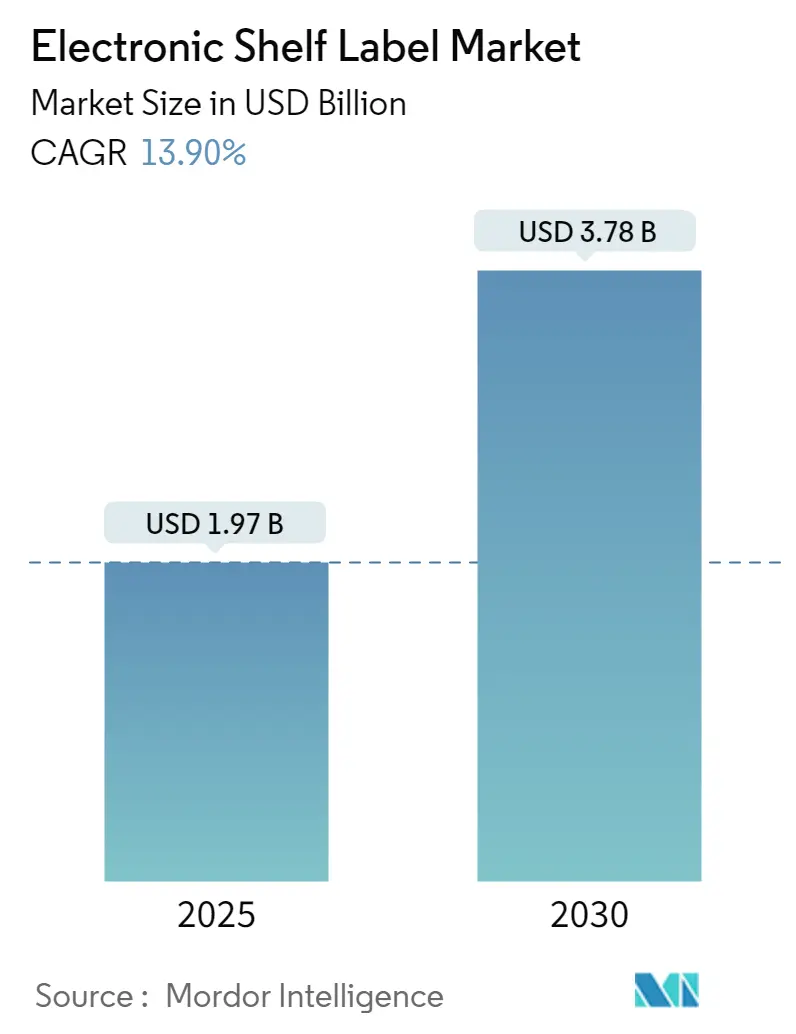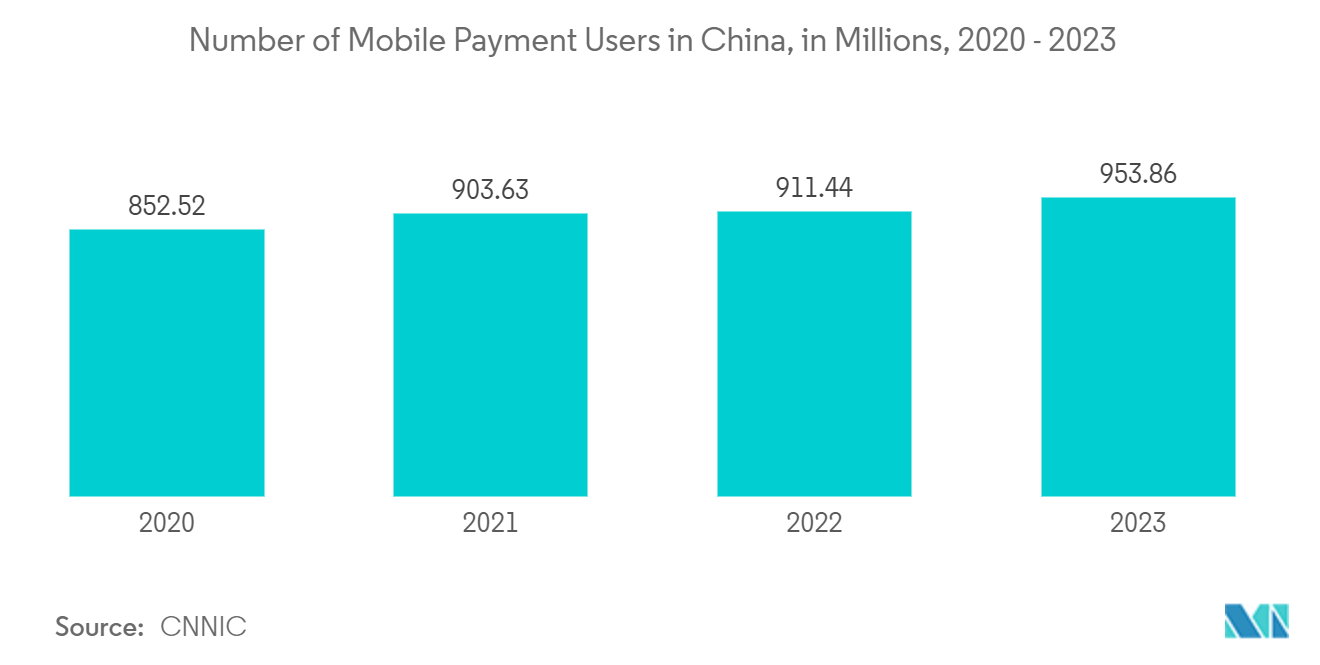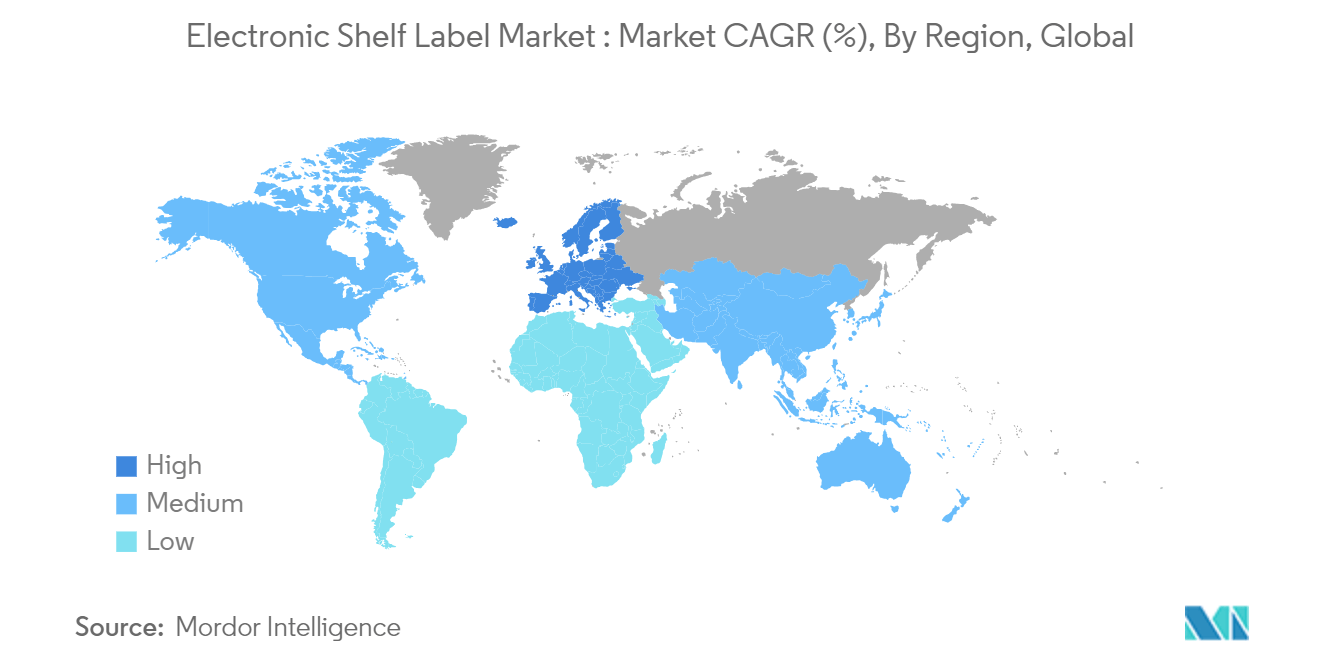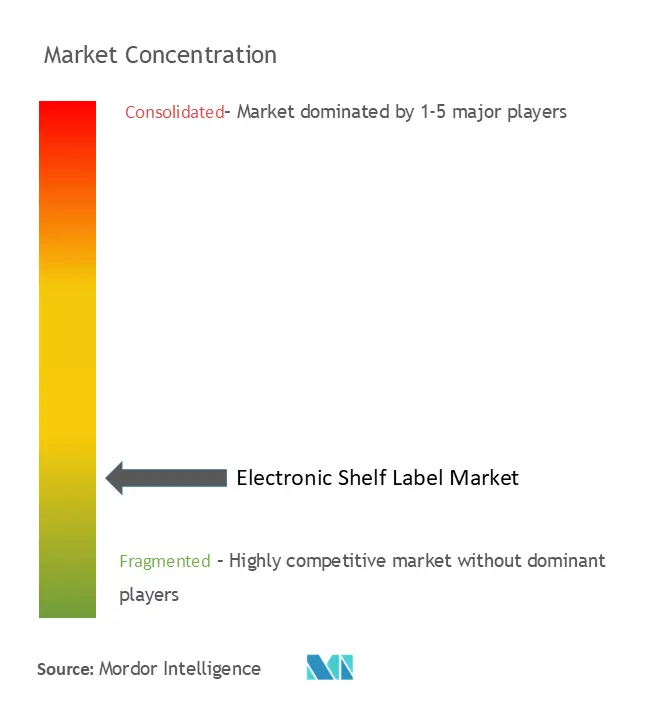Electronic Shelf Label (ESL) Market Analysis
The Electronic Shelf Label Market size is estimated at USD 1.97 billion in 2025, and is expected to reach USD 3.78 billion by 2030, at a CAGR of 13.9% during the forecast period (2025-2030).
The electronic shelf label (ESL) market has seen rising adoption across the global retail sector, driven by the need for enhanced automation, operational efficiency, and improved customer experiences. ESL technology provides a modern solution for retailers, allowing dynamic pricing and real-time product information updates through electronic price tags. As part of the larger trend toward retail automation technology, ESL systems streamline in-store operations while improving customer interactions. Large supermarkets and hypermarkets are especially keen on leveraging smart retail solutions to remain competitive in an increasingly digital landscape.
- Energy-Efficient E-Paper Shelf Labels Revolutionize Retail Pricing: E-paper shelf labels are gaining popularity due to their low energy consumption and compatibility with IoT in retail environments. Wireless shelf labels have further transformed inventory management and pricing strategies for retailers. These technologies enable electronic price display updates directly from centralized management systems, replacing the traditional, labor-intensive paper tags. The adoption of retail display technology is critical for smart store solutions and IoT-driven retail operations.
- Strategic Focus on Smart Retail Solutions: Retailers are increasingly integrating smart retail solutions, like ESLs, as part of larger strategies to improve operational efficiency and customer satisfaction. This shift aligns with the growing adoption of dynamic pricing systems, allowing retailers to adjust prices in real-time based on demand and competition. However, challenges remain, especially for small retailers facing high initial investments and integration complexities. Nevertheless, the market outlook for ESL technology remains promising, with increasing demand for retail digital signage and other smart store technologies driving growth.
Contactless Payment Technologies Driving Market Innovation
- NFC Integration Enhances ESL Capabilities: Near-field communication (NFC) technology has become a significant driver of ESL adoption in retail. NFC-enabled devices can communicate with ESL systems, offering customers real-time product information and dynamic pricing through smartphones. This trend is closely connected to the rise of IoT in retail, as businesses aim to create seamless, connected shopping experiences. Integrating electronic price display systems with point-of-sale (POS) infrastructure enhances transaction speeds and improves overall customer satisfaction.
- NFC Technology Facilitates Contactless Payments: NFC-enabled ESL systems enhance shopping convenience by allowing consumers to interact with digital price tags through their smartphones. As NFC penetration increases worldwide, retailers are presented with new opportunities to integrate price updates, promotions, and other retail automation technologies into a cohesive system. This convergence allows for faster checkout processes and immediate price adjustments, offering customers a highly responsive shopping experience.
- Dynamic Pricing Systems Linked to ESLs: Dynamic pricing systems integrated with NFC-enabled ESLs are revolutionizing the retail experience. These systems allow for immediate price changes based on fluctuating demand and supply, giving retailers a competitive edge in a fast-paced market. As more consumers adopt NFC-enabled mobile payment systems, the demand for ESL solutions is expected to rise, driving market growth in the coming years.
High Initial Investments Present a Barrier to Entry
- Significant Upfront Costs Limit ESL Adoption: Despite the long-term benefits of ESL technology, the high initial costs associated with its implementation remain a major obstacle for smaller retailers. The expenses of purchasing hardware such as E-paper shelf labels, batteries, and communication systems, along with integration into existing infrastructure, deter some businesses from investing in this retail automation technology. This limitation slows down the adoption of ESL systems, particularly in emerging markets.
- Initial Costs Offset by Long-Term Savings: While the upfront investments in ESL systems are considerable, they are often offset by long-term savings in labor costs and increased pricing accuracy. The need for fewer manual updates and the improved efficiency of automated systems provide a strong return on investment for large retail chains. However, smaller retailers may struggle with the complexities of integrating ESL systems into existing POS and inventory management platforms.
- Challenges in Integration and Maintenance: For small retailers, maintaining and upgrading these systems presents additional challenges. The technical complexities of integrating ESL systems with existing retail automation technology can strain resources, slowing the market's overall growth. Nonetheless, larger retail chains continue to adopt ESL technology, driven by the promise of operational efficiency and real-time pricing updates.
Electronic Shelf Label (ESL) Market Trends
NFC Mobile Payment is expected to boost market growth
- NFC Integration Revolutionizes ESL: The integration of NFC technology is reshaping the ESL market, allowing consumers to interact with digital price tags via smartphones for faster mobile payments. This innovation enhances transaction speeds and offers real-time product information, elevating the customer shopping experience.
- Dynamic Pricing Improves Store Efficiency: Automated pricing systems connected to NFC-enabled ESLs allow retailers to adjust prices immediately based on demand, competition, and market trends. This dynamic pricing system helps stores stay competitive and offers a more efficient and responsive retail environment, boosting sales.
- E-Paper Technology Improves Operational Efficiency: E-paper shelf labels, which consume minimal energy and offer clear, high-resolution displays, are becoming a preferred choice in retail. These labels can be updated remotely, reducing the need for manual price changes and increasing staff efficiency. As part of the IoT trend in retail, ESLs contribute to better inventory management and store operations.
- Demand for Smart Retail Solutions Grows: The demand for smart store solutions is driving market growth, with NFC-enabled ESL systems playing a central role. Retailers are investing in ESL technology to enhance customer engagement and operational efficiency, contributing to the expansion of retail automation technologies worldwide.
North America to Hold a Major Market Share
- Advanced Retail Infrastructure Fuels ESL Adoption: North America leads the ESL market due to its advanced retail automation technology infrastructure. U.S. and Canadian retailers are at the forefront of adopting smart store solutions, driven by the need for operational efficiency and improved customer experiences. The presence of major retail chains in the region further drives the implementation of electronic price display systems.
- IoT Integration Boosts Real-Time Efficiency: North American retailers are leveraging IoT-enabled ESL systems to collect real-time data on consumer behavior, inventory levels, and pricing trends. This data allows retailers to make more informed decisions, enhancing inventory management, pricing strategies, and store operations.
- High Demand for Retail Digital Signage and E-Paper Labels: The competitive nature of the North American retail market is driving demand for retail digital signage and e-paper shelf labels. These technologies enable real-time updates on promotions and pricing, improving in-store efficiency and customer experiences.
- Favorable Regulatory Environment Supports Growth: Government support for technological innovation in the U.S. accelerates the adoption of retail automation solutions like ESLs. Retailers are increasingly focusing on customer-centric technologies such as wireless shelf labels and dynamic pricing systems, positioning North America as a key region for ESL market growth.
Electronic Shelf Label (ESL) Industry Overview
Fragmented Market with Diverse Players: The ESL market is highly fragmented, with both large corporations and specialized companies competing for market share. Major global players like Samsung Electro-Mechanics and Panasonic Corporation dominate, while firms such as Pricer AB and Displaydata Ltd offer innovative ESL solutions, contributing to a diverse and competitive market landscape.
Key Leaders Driving Innovation: Companies like E Ink Holdings Inc., Displaydata Ltd, and Samsung Electro-Mechanics are known for their advanced electronic display technologies and significant influence in the global retail sector. These companies have solidified their market positions by delivering comprehensive retail automation solutions.
Future Market Success Tied to Technological Advancements: Key trends shaping the future of the ESL market include the growing demand for real-time pricing updates and smart retail solutions. For continued success, companies must focus on energy-efficient ESL systems, seamless integration with store management systems, and the capacity to support dynamic pricing strategies. As wireless communication technologies advance, businesses capable of handling large-scale inventories will maintain a competitive edge.
Electronic Shelf Label (ESL) Market Leaders
-
E Ink Holdings Inc.
-
Displaydata Ltd
-
Samsung Electro-Mechanics Co. Ltd
-
Pricer AB
-
Panasonic Corporation
- *Disclaimer: Major Players sorted in no particular order
Electronic Shelf Label (ESL) Market News
- May 2024 -3M has partnered with JRTech Solutions to implement Pricer Electronic Shelf Labels (ESL) in a revolutionary digital tracking and documentation system at 3M's Brockville, Ontario Production Site, showcasing the versatility and potential of ESL technology beyond retail applications. This collaboration demonstrates the adaptability of Pricer's Infrared communication platform in manufacturing processes, potentially opening new markets for electronic shelf label technology and highlighting its capabilities in improving efficiency and accuracy in industrial settings.
- May 2023 - Pricer and StrongPoint have launched a new generation of electronic shelf labels (ESLs) called Pricer SmartTag Color, featuring high-resolution graphics in four colors: yellow, red, black, and white. This innovation enhances in-store communication and operational efficiency, offering improved visibility for customers and advanced features like pick-by-light for store staff, potentially revolutionizing the electronic shelf-label market by providing more versatile and engaging display options for retailers.
- February 2023 - Qualcomm Technologies and SES-imagotag have announced a collaboration to develop new electronic shelf labels (ESLs) based on the recently approved Bluetooth SIG wireless standard, aiming to create an interoperable ESL ecosystem in retail. This partnership marks a significant shift from proprietary protocols to standardized technology in the ESL market, potentially revolutionizing retail operations by offering improved automation, efficiency, and customer experiences through scalable, ultra-low power, and highly secure ESL solutions.
Electronic Shelf Label (ESL) Industry Segmentation
Electronic Shelf Label (ESL) is used by retailers to display product pricing on shelves. The product pricing is automatically updated (whenever the price gets changed) from a central control server.
The electronic shelf label market is segmented by type of product (LCD ESLs and E-paper ESLs), store type (hyper markets, super markets, specialty stores and non-food retail stores), and geography (North America, Europe, Asia Pacific, Latin America, Middle East and Africa). The market sizes and forecasts are provided in terms of value (USD) for all the above segments.
| By Product | LCD ESLs |
| E-paper ESLs | |
| By Store Type | Hyper Markets |
| Super Markets | |
| Specialty Stores and Non-food Retail Stores | |
| By Geography | North America |
| Europe | |
| Asia Pacific | |
| Latin America | |
| Middle East and Africa |
Electronic Shelf Label (ESL) Market Research FAQs
How big is the Electronic Shelf Label Market?
The Electronic Shelf Label Market size is expected to reach USD 1.97 billion in 2025 and grow at a CAGR of 13.90% to reach USD 3.78 billion by 2030.
What is the current Electronic Shelf Label Market size?
In 2025, the Electronic Shelf Label Market size is expected to reach USD 1.97 billion.
Who are the key players in Electronic Shelf Label Market?
E Ink Holdings Inc., Displaydata Ltd, Samsung Electro-Mechanics Co. Ltd, Pricer AB and Panasonic Corporation are the major companies operating in the Electronic Shelf Label Market.
Which is the fastest growing region in Electronic Shelf Label Market?
Europe is estimated to grow at the highest CAGR over the forecast period (2025-2030).
Which region has the biggest share in Electronic Shelf Label Market?
In 2025, the North America accounts for the largest market share in Electronic Shelf Label Market.
What years does this Electronic Shelf Label Market cover, and what was the market size in 2024?
In 2024, the Electronic Shelf Label Market size was estimated at USD 1.70 billion. The report covers the Electronic Shelf Label Market historical market size for years: 2019, 2020, 2021, 2022, 2023 and 2024. The report also forecasts the Electronic Shelf Label Market size for years: 2025, 2026, 2027, 2028, 2029 and 2030.
Our Best Selling Reports
Electronic Shelf Label Industry Report
Electronic Shelf Label (ESL) Market Research
Our industry analysis delves into the growing electronic shelf label (ESL) market, focusing on its adoption within the global retail landscape. The report provides a comprehensive overview of ESL technology, highlighting key trends such as dynamic pricing systems, IoT integration, and the rise of smart store solutions. It includes detailed insights into retail automation technology, with particular emphasis on innovations like e-paper shelf labels and NFC-enabled wireless shelf labels. The report pdf offers in-depth market segmentation, trends, and growth predictions, equipping stakeholders with actionable data to stay competitive.
By examining market forecasts, industry size, and sales trends, this report aids stakeholders in identifying opportunities and challenges within the ESL market. The industry's competitive landscape is thoroughly analyzed, showcasing how technological advancements in electronic price display and digital price tags are reshaping retail operations. Available in a report pdf format, the document provides a clear roadmap for businesses looking to leverage smart retail solutions for enhanced customer experiences and operational efficiency.

.webp)





